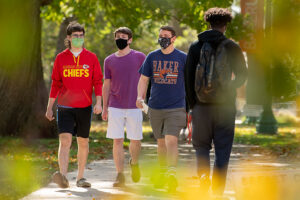The Baker University Wetlands is no stranger to change. Created over thousands of years through repeated flooding of the Wakarusa River, it was drained in the early 1900s for farming. When Baker University acquired the land in 1968, biology students and faculty began the long process of restoring the property back to wetlands. Today, nearly 100 percent of the 927 acres have been restored or are in the process of restoration. This effort has provided countless Baker students with a one-of-a-kind hands-on learning experience. Recent sudden changes are again providing unique opportunities for education and growth.
Tornado damage presents a rare research opportunity
On May 28, 2019, two tornadoes traveled 39 miles through Douglas and Leavenworth counties. The path of destruction included nine acres of the Baker University Wetlands located 10 miles north of the Baldwin City campus.

Although it is easy to view destruction as a disaster, Dr. Scott Kimball, ’99, assistant professor of biology, recognizes that tornadoes are a natural occurrence in forest environments. The occurrence, categorized as a disturbance, is not necessarily a bad thing and offers significant possibilities.
Beginning last fall, students in Kimball’s Forest Ecology classes have been collecting data from the area to learn about how the forest responds to the disturbance. Except for the research, this damaged area has remained untouched.
“It’s unusual that a tornado hits a research station at all. Just the fact that we had an opportunity to experience a disturbance like that was very unique. Disturbance research is rarely done on tornadoes because tornadoes are so unpredictable. You can’t plan for tornado research.”
Dr. Scott Kimball, ’99, assistant professor of biology
With endless research possibilities, students are focusing on how the forest and species composition has reacted. Fallen, dead, or dying trees, known as coarse woody debris, are being examined to determine how the regeneration process happens over time and how these trees are incorporated into the forest. Students are also researching how birds in the area have reacted.

“This opportunity impacted my education in such a positive way. Learning and understanding how a riparian forest reacts and overcomes a natural disaster is really a once-in-a-lifetime experience, especially in the Midwest. Being able to collect this starting data for future Forest Ecology students to build on, and even use for their own personal projects, is super exciting.”
Lucy McCleary, Forest Ecology student
This unique research opportunity will continue for years, with a goal of including the public and integrating other research efforts. In July, Baker students and faculty started a three-year research project on tardigrades at the Wetlands. The tardigrade research, supported by a National Science Foundation grant, will include this damaged area. Dr. Kimball hopes to invite additional researchers and scientists to the area in the coming years and to start outreach projects for public involvement.
“Having something that we can study for 20 or 30 years is really unique. The long-term monitoring is not something that happens often. It is contributing to science in a way that is often not contributed to anymore,” said Dr. Irene Unger, director of the Baker University Wetlands and associate professor of biology, who oversees all the research.
Center closure spurs innovation
The Wetlands has experienced another disturbance in the last year. In response to the COVID-19 pandemic, the Wetlands Discovery Center, an 11,000-square-foot education facility that is open to the public and offers lab space for students, closed to the public in March, while the trails remained open. Employees took advantage of this break to work inside, creating new ways for people to experience the Wetlands and use the Discovery Center, which reopened July 5.
The Discovery Center typically hosts Nature Tots, a monthly program for young children. Morgan Glade, education and outreach coordinator, who leads Nature Tots, resumed the program in October. Although attendance at each session will be limited, additional sessions will be scheduled, and activities will take place outside as much as possible.

An addition to the Discovery Center, the Wonder Room, was created during the closure. The Wonder Room features six curiosity cabinets for children to explore. These cabinets contain rocks and minerals, mammals, reptiles and amphibians, invertebrates, and birds. Drawers in the Wonder Room also hold artifacts for children to look at without touching. All elements in the cabinets were found in Kansas, some near the Wetlands.
Another touch-free option, QR codes, are being placed on the trail signs to let visitors know what they might observe while enjoying the trails. The QR codes can be scanned on a phone and bring up a video about a topic such as poison ivy, wildlife, or fun facts about the Wetlands.
While the Discovery Center was closed for updates, the trails remained open, and in July, the Wetlands was featured by Fox 4 News as a part of its Zip Trips series, which focuses on unique places within driving distance of the Kansas City metropolitan area. Check out the feature on the Fox 4 News website.
Although the pandemic might have temporarily disturbed the Discovery Center and events, the Wetlands staff have remained committed to its motto of restoration, education, and research.
“If they know something, they’ll love it. And if they love it, they’ll protect it.”
Dr. Irene Unger, director of the Baker University Wetlands and associate professor of biology
Although initially these disturbances appeared to provide only setbacks, it quickly became apparent they also offered opportunities: restoration research that will continue for years and the development of innovative and safe ways to educate the public.
Learn more about the Baker University Wetlands by visiting the area and connecting on Facebook, Twitter, and Instagram.





